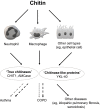Chitinases and Chitinase-Like Proteins in Obstructive Lung Diseases - Current Concepts and Potential Applications
- PMID: 32368034
- PMCID: PMC7185641
- DOI: 10.2147/COPD.S236640
Chitinases and Chitinase-Like Proteins in Obstructive Lung Diseases - Current Concepts and Potential Applications
Abstract
Chitinases, enzymes that cleave chitin's chain to low molecular weight chitooligomers, are widely distributed in nature. Mammalian chitinases belong to the 18-glycosyl-hydrolase family and can be divided into two groups: true chitinases with enzymatic activity (AMCase and chitotriosidase) and chitinase-like proteins (CLPs) molecules which can bind to chitin or chitooligosaccharides but lack enzymatic activity (eg, YKL-40). Chitinases are thought to be part of an innate immunity against chitin-containing parasites and fungal infections. Both groups of these hydrolases are lately evaluated also as chemical mediators or biomarkers involved in airway inflammation and fibrosis. The aim of this article is to present the current knowledge on the potential role of human chitinases and CLPs in the pathogenesis, diagnosis, and course of obstructive lung diseases. We also assessed the potential role of chitinase and CLPs inhibitors as therapeutic targets in chronic obstructive pulmonary disease and asthma.
Keywords: AMCase; CHIT1; COPD; YKL-40; asthma; chitotriosidase.
© 2020 Przysucha et al.
Conflict of interest statement
KG reports fees for lectures and travel expenses from Boehringer Ingelheim, Chiesi, AstraZeneca, Polpharma and Roche, outside the submitted work. RK reports personal fees and non-financial support from Boehringer Ingelheim, Chiesi, and AstraZeneca; and personal fees from Polpharma, outside the submitted work. The authors report no other conflicts of interest in this work.
Figures



References
-
- Shahidi F, Abuzaytoun R. Chitin, chitosan, and co-products: chemistry, production, applications, and health effects. Adv Food Nutr Res. 2005;49:93–135. - PubMed
-
- Sharp RG. A review of the applications of chitin and its derivatives in agriculture to modify plant-microbial interactions and improve crop yields. Agronomy. 2013;3(4):757–793. doi:10.3390/agronomy3040757 - DOI
Publication types
MeSH terms
Substances
LinkOut - more resources
Full Text Sources
Medical
Miscellaneous

